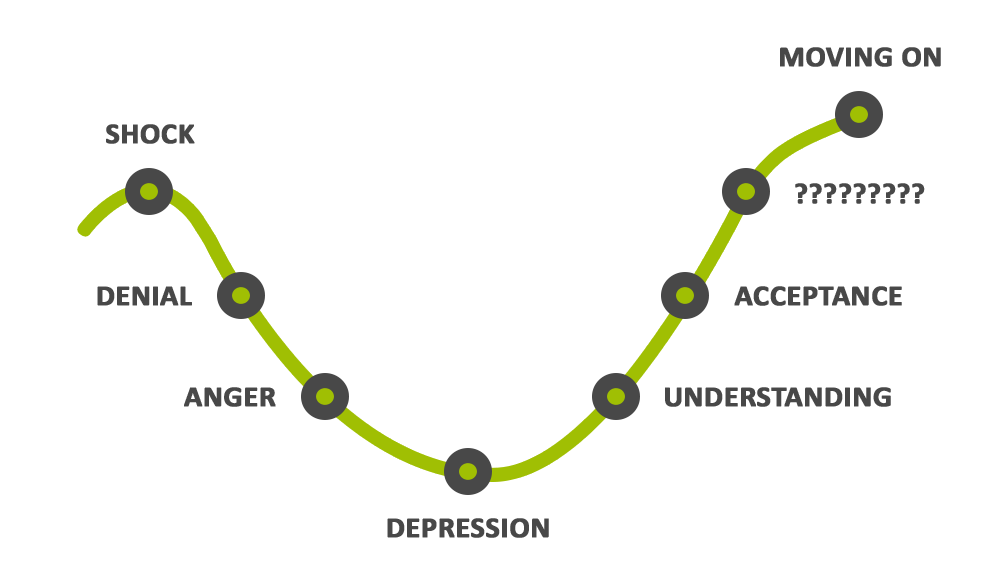Have you had enough? You’ve invested a lot of time and resources into building relationships with your members. You’ve forged strong attachments by providing reliable and effective service that prioritizes your members’ interests. You’ve been empathetic during turbulent times, providing assurance of financial stability.
If you’ve had enough of all that – if you’re ready to “liberate” your members from their attachments to you, freeing them to join the competition – you’ve come to the right place! But this is also the right place to learn how to keep your members close to you through periods of change and uncertainty, ensuring that they will stay loyal to you as you prepare to face What Comes Next…

Setting the Stages
You might be familiar with the chart above. This kind of model, the Change Curve, is often known by other names. You might recognize it as the stages a person who is experiencing grief or PTSD goes through. Any time a person, an organization, or even a society has to adapt to a new situation, especially one that is sudden and unexpected, they tend to go through a period of crisis or trauma. What we’ve all gone through so far in 2020 is certainly worthy of being called a “crisis”! Keep in mind, all of your employees are somewhere on this curve. Your C-team is somewhere on this curve. And certainly your members are somewhere on this curve. Let’s take a ride…
Stage One: SHOCK
This was the first reaction when the COVID-19 pandemic hit. The response of, “This can’t be happening!” was followed by the realization of damage sustained (that punched-in-the-gut feeling).
Stage Two: DENIAL
After the initial blow, we told ourselves: “This is no big deal. Nothing’s really going to change.” We may have stubbornly persisted until we were forced to realize things actually WERE changing, and in a profound way.
Stage Three: ANGER
There’s definitely some energy here, as we experience loss of control. But when the industry, consumers, C-team, employees, and organizations expend that energy in fighting and working to resist the change, and then they realize their best efforts aren’t enough, emotional fatigue sets in. Then you’ve reached…
Stage Four: DEPRESSION
No place to go but up…but we could be here a while. Time to muster our resources and energy, and collect the information and resilience we need to begin the climb toward…
Stage Five: UNDERSTANDING
We are fighting an uphill battle. Everyone may be in different places. And all of your members are forced to adapt to a reality we don’t recognize and haven’t navigated through yet. The same process occurs with someone who experiences a deep grief for the first time. The first time, you think you’re never going to be able to move on. But once you’ve experienced this kind of grief a few times, then you start to see that you’re going to be able to move on.
Leaders may come up against the lowest energy level in their organization just before Understanding occurs. The challenge is to keep your teams motivated until you reach your objective. For credit unions, the motivation is the mission: being there for your members when they need you the most. Credit unions across the country have lived up to their stated mission and values during the pandemic, alleviating the financial stress on their members through such practices as waiving fees and penalties, and offering flexible payment accommodations. Many credit unions have also found ways to contribute directly to their communities, through such initiatives as donating PPE to healthcare workers and first responders, and providing meals to residents of assisted living and nursing care facilities. To help people and their communities when they are at their worst can cement a foundation of loyalty like nothing else.
Stage Six: ACCEPTANCE
What must you as a financial institution, as well as the industry itself, accept in order to move on successfully to what needs to be next? This is where you finally embrace the new reality: Without the ability to make the right choices to Move On (or Move Forward), and to make them quickly and insightfully, you will become just one more choice in a world of commoditization.
Only after the organization has reached Acceptance can it follow a new path – one that leads to intentional and purposeful transformation. Congratulations on getting here – but now the real work begins!
Stage Seven (The Missing Stage): ADAPTATION
This is the stage I would add to the Change Curve: Adaptation. To confront the future across the full footprint of your business, from front office to back office, including products, processes, people and channels, you need immense agility in your operating model, your strategy, and your decision making. With the accelerated pace of change and continued uncertainty, today’s strategic plan is likely going to cover three months rather than three years! Decisions have to come quicker, and as much as possible you want to anticipate change and be ahead of it, rather than simply reacting to it.
To drive these decisions, you need hard data – clear facts that identify the problems that should take priority – so you can lead your organization in the right direction. Then you need agility, so that when new facts are presented, you can intelligently pivot to sidestep obstacles in your way.
Stage Eight: MOVING ON…Together
In order to have a clear path forward, you need to act in such a way that you are still differentiated as you move on to What Comes Next. It’s no secret that the future is going to be dominated by digital. Even before the pandemic, some of your members changed on their own as early adopters of the latest technology. But a lot of your members were suddenly forced into using digital channels. What you need to listen for is when those members have experiences with the technology that prompt them to say, “I DON’T like it.” It is this portion of your membership – the Forced Adopters in the Denial or Anger stage, or just fatigued with having to do business this way – who will be “liberated” from you and quickly absorbed by the competition.
A recent PwC survey found that the likelihood of consumers switching their primary bank in the coming months has nearly tripled! You risk liberating your members to be a part of that segment by delivering an experience through the technology that is not what they expect based on their previous face-to-face experiences. When your members encounter friction in a digital-led experience, the human support has to be there. If the digital experience comes up short – and the human support for those channels is not a differentiating factor – your members are prime candidates for the competition. What can you do to avoid liberating your members in this digital environment? Preserve the human connection as you advance them through no-touch channels. If you successfully adapt how you build and strengthen member relationships, you will preserve your greatest asset for the next stage – an agile future with loyal members for life.
Let us demonstrate how data-driven insight can reveal how your members are experiencing you through your digital channels. Find out whether the human support of those channels is up to the task of bringing your members closer to you…or driving them away:






















